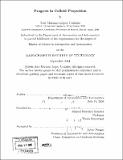Progress in colloid propulsion
Author(s)
López Urdiales, Jóse Mariano, 1977-
DownloadFull printable version (4.323Mb)
Other Contributors
Massachusetts Institute of Technology. Dept. of Aeronautics and Astronautics.
Advisor
Manual Martínez Sánchez.
Terms of use
Metadata
Show full item recordAbstract
In the early decades of the Space Age, a great deal of work was put into the development of the Colloid Thruster as an electric propulsion system for spacecraft. In spite of the effort by the end of the 70s the programs were stopped in the USA and Europe before any design had gotten to fly in space. An exhaustive study of the literature has been performed to identify what were the reasons behind the disappearance of Colloid Thrusters. Apart from programmatic reasons related to the introduction of the Space Shuttle, some technical reasons where identified. The technical difficulties had to do with the use of arrays of needles. Aiming at overcoming these difficulties, an alternative way to construct Colloid Thrusters has been proposed. Instead of needles, holes in Teflon where used. This has been tested both numerically and experimentally with positive results. This development may be useful not only for colloid propulsion but also for other technologies that require electrospray emission.
Description
Thesis (S.M.)--Massachusetts Institute of Technology, Dept. of Aeronautics and Astronautics, 2004. Includes bibliographical references (p. 61-68).
Date issued
2004Department
Massachusetts Institute of Technology. Department of Aeronautics and AstronauticsPublisher
Massachusetts Institute of Technology
Keywords
Aeronautics and Astronautics.